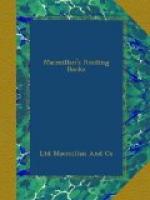When pinched with hunger they will swallow almost anything, and on a journey it is necessary to secure the harness within the snow-house over night, lest, by devouring it, they should render it impossible to proceed in the morning. When the travellers arrive at their night quarters, and the dogs are unharnessed, they are left to burrow on the snow, where they please, and in the morning are sure to come at their driver’s call, when they receive some food. Their strength and speed; even with a hungry stomach, is astonishing. In fastening them to the sledge, care is taken not to let them go abreast. They are tied by separate thongs, of unequal lengths, to a horizontal bar in the fore part of the sledge; an old knowing one leads the way, running ten or twenty paces ahead, directed by the driver’s whip, which is of great length, and can be well managed only by an Esquimaux. The other dogs follow like a flock of sheep. If one of them receives a lash, he generally bites his neighbour, and the bite goes round.
To return to our travellers. The sledge contained five men, one woman, and a child. All were in good spirits, and appearances being much in their favour, they hoped to reach Okkak in safety in two or three days. The track over the frozen sea was in the best possible order, and they went with ease at the rate of six or seven miles an hour. After they had passed the islands in the bay of Nain, they kept at a considerable distance from the coast, both to gain the smoothest part of the ice, and to weather the high rocky promontory of Kiglapeit. About eight o’clock they met a sledge with Esquimaux turning in from the sea. After the usual salutation, the Esquimaux, alighting, held some conversation, as is their general practice, the result of which was, that some hints were thrown out by the strange Esquimaux that it might be better to return. However, as the missionaries saw no reason whatever for it, and only suspected that the Esquimaux wished to enjoy the company of their friends a little longer, they proceeded. After some time, their own Esquimaux hinted that there was a ground swell under the ice. It was then hardly perceptible, except on lying down and applying the ear close to the ice, when a hollow, disagreeably grating and roaring noise was heard, as if ascending from the abyss. The weather remained clear, except towards the east, where a bank of light clouds appeared, interspersed with some dark streaks. But the wind being strong from the north-west, nothing less than a sudden change of weather was expected. The sun had now reached its height, and there was as yet little or no alteration in the appearance of the sky. But the motion of the sea under the ice had grown more perceptible, so as rather to alarm the travellers, and they began to think it prudent to keep closer to the shore. The ice had cracks and large fissures in many places, some of which formed chasms of one or two feet wide; but as they are not uncommon even in its best state, and the dogs easily leap over them, the sledge following without danger, they are only terrible to new comers.




